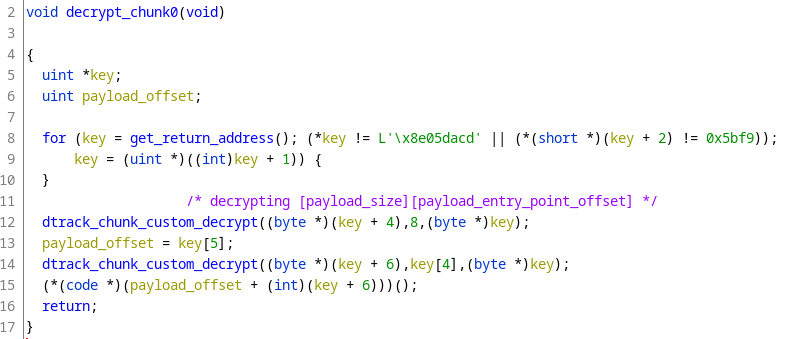
Introduction
DTrack is a backdoor used by the Lazarus group. Initially discovered in 2019, the backdoor remains in use three years later. It is used by the Lazarus group against a wide variety of targets. For example, we’ve seen it being used in financial environments where ATMs were breached, in attacks on a nuclear power plant and also in targeted ransomware attacks. Essentially, anywhere the Lazarus group believes they can achieve some financial gain.
DTrack allows criminals to upload, download, start or delete files on the victim host. Among those downloaded and executed files already spotted in the standard DTrack toolset there is a keylogger, a screenshot maker and a module for gathering victim system information. With a toolset like this, criminals can implement lateral movement into the victims’ infrastructure in order to, for example, retrieve compromising information.
As part of our crimeware reporting service, we published a new private report about recent Dtrack activity. In this public article we highlight some of the main findings shared in that report. For more information about our crimeware reporting service, please contact crimewareintel@kaspersky.com.
So, what’s new?
DTrack itself hasn’t changed much over the course of time. Nevertheless, there are some interesting modifications that we want to highlight in this blogpost. Dtrack hides itself inside an executable that looks like a legitimate program, and there are several stages of decryption before the malware payload starts.
First stage – implanted code
DTrack unpacks the malware in several stages. The second stage is stored inside the malware PE file. To get it, there are two approaches:
- offset based;
- resource based.
The idea is that DTrack retrieves the payload by reading it from an offset within the file or by reading it from a resource within the PE binary. An example of a decompiled pseudo function that retrieves the data using the offset-based approach can be found below.
Example of DTrack offset-oriented retrieval function
After retrieving the location of the next stage and its key, the malware then decrypts the buffer (with a modified RC4 algorithm) and passes control to it. To figure out the offset of the payload, its size and decryption keys, DTrack has a special binary (we have dubbed it ‘Decrypt config’) structure hidden in an inconspicuous part of the PE file.
Second stage – shellcode
The second stage payload consists of heavily obfuscated shellcode as can be seen below.
Heavily obfuscated second stage shellcode
The encryption method used by the second layer differs for each sample. So far, we have spotted modified versions of RC4, RC5 and RC6 algorithms. The values of the third stage payload and its decryption key are obtained by reading Decrypt config again.
One new aspect of the recent DTrack variants is that the third stage payload is not necessarily the final payload; there may be another piece of binary data consisting of a binary configuration and at least one shellcode, which in turn decrypts and executes the final payload.
Third stage – shellcode and final binary
The shellcode has some quite interesting obfuscation tricks to make analysis more difficult. When started, the beginning of the key (used to decrypt the final payload) is searched for. For example, when the beginning of the key is 0xDEADBEEF, the shellcode searches for the first occurrence of 0xDEADBEEF.
Chunk decryption routine example
Once the key is found, the shellcode uses it to decrypt the next eight bytes after the key, which form yet another configuration block with final payload size and its entry point offset. The configuration block is followed by an encrypted PE payload that starts at the entry point offset after decryption with the custom algorithm.
Final payload
Once the final payload (a DLL) is decrypted, it is loaded using process hollowing into explorer.exe. In previous DTrack samples the libraries to be loaded were obfuscated strings. In more recent versions they use API hashing to load the proper libraries and functions. Another small change is that three C2 servers are used instead of six. The rest of the payload’s functionality remains the same.
Infrastructure
When we look at the domain names used for C2 servers, a pattern can be seen in some cases. For example, the actors combine a color with the name of an animal (e.g., pinkgoat, purplebear, salmonrabbit). Some of the peculiar names used in the DTrack infrastructure can be found below:
| Domain | IP | First seen | ASN |
| pinkgoat.com | 64.190.63.111 | 2022‑03‑03 15:34 | AS47846 |
| purewatertokyo.com | 58.158.177.102 | 2022‑05‑20 16:07 | AS17506 |
| purplebear.com | 52.128.23.153 | 2021‑01‑08 08:37 | AS19324 |
| salmonrabbit.com | 58.158.177.102 | 2022‑05‑20 09:37 | AS17506 |
Victims
According to KSN telemetry, we have detected DTrack activity in Germany, Brazil, India, Italy, Mexico, Switzerland, Saudi Arabia, Turkey and the United States, indicating that DTrack is spreading into more parts of the world. The targeted sectors are education, chemical manufacturing, governmental research centers and policy institutes, IT service providers, utility providers and telecommunications.
Conclusions
The DTrack backdoor continues to be used actively by the Lazarus group. Modifications in the way the malware is packed show that Lazarus still sees DTrack as an important asset. Despite this, Lazarus has not changed the backdoor much since 2019, when it was initially discovered. When the victimology is analyzed, it becomes clear that operations have expanded to Europe and Latin America, a trend we’re seeing more and more often.
IOCs
C2 domains
pinkgoat[.]com
purewatertokyo[.]com
purplebear[.]com
salmonrabbit[.]com
MD5
1A74C8D8B74CA2411C1D3D22373A6769
67F4DAD1A94ED8A47283C2C0C05A7594
























DTrack activity targeting Europe and Latin America